Construction-Induced Waterlogging Simulation in Pinglu Canal Using a Coupled SWMM-HEC-RAS Model: Implications for Inland Waterway Engineering
Abstract
1. Introduction
- (1)
- Reveal spatiotemporal evolution mechanisms of channel waterlogging under combined dynamic topography and anthropogenic interventions;
- (2)
- Enable dynamic optimization of drainage infrastructure deployment;
- (3)
- Provide actionable insights for ensuring timely canal commissioning and enhancing water safety management in comparable projects.
2. Materials and Methods
2.1. Study Area
2.2. SWMM Model
2.3. HEC-RAS 2D Model
2.4. A Coupled SWMM-HEC-RAS 2D Model
2.5. Data Sources
3. Results and Discussion
3.1. Calibration and Validation of SWMM Model
3.2. Construction of SWMM-HEC-RAS 2D Coupling Model
3.3. Result Analysis
3.3.1. Simulation Analysis of Ponding Under Different Return Period Design Rainstorm Scenarios
3.3.2. Simulation Analysis of Ponding Under Real Rainfall During Construction
4. Conclusions
Author Contributions
Funding
Data Availability Statement
Conflicts of Interest
References
- Guangxi Zhuang Autonomous Region People’s Government. Press Conference on “Guangxi Accelerating the Construction of Major Infrastructure and Building the Pinglu Canal with High Standards and Quality”. Available online: http://www.gxzf.gov.cn/zt/xwfb/wssthjbh0728_211489/dt/t18583470.shtml (accessed on 20 June 2024).
- Zhang, X.; Qiao, W.; Xiao, Y.; Lu, Y. Analysis of Regional Flooding in the Urbanization Expansion Process Based on the SWMM Model. Nat. Hazards 2023, 117, 1349–1363. [Google Scholar] [CrossRef]
- Dasallas, L.; An, H.; Lee, S. Developing an Integrated Multiscale Rainfall-Runoff and Inundation Model: Application to an Extreme Rainfall Event in Marikina-Pasig River Basin, Philippines. J. Hydrol. Reg. Stud. 2022, 39, 100995. [Google Scholar] [CrossRef]
- Rajib, A.; Golden, H.E.; Lane, C.R.; Wu, Q. Surface Depression and Wetland Water Storage Improves Major River Basin Hydrologic Predictions. Water Resour. Res. 2020, 56, e2019WR026561. [Google Scholar] [CrossRef]
- Cheng, X.; Ma, X.; Wang, W.; Xiao, Y.; Wang, Q.; Liu, X. Application of HEC-HMS Parameter Regionalization in Small Watershed of Hilly Area. Water Resour. Manag. 2021, 35, 1961–1976. [Google Scholar] [CrossRef]
- Lv, P.; Kong, L.; Chuo, R.; Liu, H.; Cai, S.; Zhao, M. Application of One-Dimensional Hydrodynamic Coupling Model in Complex River Channels: Taking the Yongding River as an Example. Water 2024, 16, 1161. [Google Scholar] [CrossRef]
- Rossman, L.A. Storm Water Management Model User’s Manual, Version 5.0; National Risk Management Research Laboratory, Office of Research and Development, US Environmental Protection Agency: Cincinnati, OH, USA, 2010.
- Zhao, W.J.; Sun, W.; Li, Z.L.; Fan, Y.W.; Song, J.S.; Wang, L.R. A Review on SWAT Model for Stream Flow Simulation. Adv. Mater. Res. 2013, 726–731, 3792–3798. [Google Scholar] [CrossRef]
- Nasiri, S.; Ansari, H.; Ziaei, A.N. Simulation of Water Balance Equation Components Using SWAT Model in Samalqan Watershed (Iran). Arab. J. Geosci. 2020, 13, 421. [Google Scholar] [CrossRef]
- Beven, K.J.; Kirkby, M.J. A Physically Based, Variable Contributing Area Model of Basin Hydrology/Un Modèle à Base Physique de Zone d’Appel Variable de l’Hydrologie Du Bassin Versant. Hydrol. Sci. Bull. 1979, 24, 43–69. [Google Scholar] [CrossRef]
- Beven, K.J.; Kirkby, M.J.; Freer, J.E.; Lamb, R. A History of TOPMODEL. Hydrol. Earth Syst. Sci. 2021, 25, 527–549. [Google Scholar] [CrossRef]
- Goudarzi, S.; Milledge, D.; Holden, J. A Generalized Multistep Dynamic (GMD) TOPMODEL. Water Resour. Res. 2023, 59, e2022WR032198. [Google Scholar] [CrossRef]
- Li, Z.; Xin, P.; Tang, J. Study of the Xinanjiang Model Parameter Calibration. J. Hydrol. Eng. 2013, 18, 1513–1521. [Google Scholar] [CrossRef]
- Zhao, R.J. The Xinanjiang Model Applied in China. J. Hydrol. 1992, 135, 371–381. [Google Scholar] [CrossRef]
- Zang, S.; Li, Z.; Zhang, K.; Yao, C.; Liu, Z.; Wang, J.; Huang, Y.; Wang, S. Improving the Flood Prediction Capability of the Xin’anjiang Model by Formulating a New Physics-Based Routing Framework and a Key Routing Parameter Estimation Method. J. Hydrol. 2021, 603, 126867. [Google Scholar] [CrossRef]
- Patel, D.P.; Ramirez, J.A.; Srivastava, P.K.; Bray, M.; Han, D. Assessment of Flood Inundation Mapping of Surat City by Coupled 1D/2D Hydrodynamic Modeling: A Case Application of the New HEC-RAS 5. Nat. Hazards 2017, 89, 93–130. [Google Scholar] [CrossRef]
- Arash, A.M.; Yasi, M. The Assessment for Selection and Correction of RS -Based DEMs and 1D and 2D HEC-RAS Models for Flood Mapping in Different River Types. J. Flood Risk Manag. 2022, 16, e12871. [Google Scholar] [CrossRef]
- Dahal, V.; Kunwar, S.; Bhandari, S.; Chaudhary, S.; Gautam, S.; Bhatt, N.; Regmi, R.K. Analyzing Sedimentation Patterns in the Naumure Multipurpose Project (NMP) Reservoir Using 1D HEC-RAS Modeling. Sci. Rep. 2024, 14, 22134. [Google Scholar] [CrossRef]
- Panda, R.K.; Pramanik, N.; Bala, B. Simulation of River Stage Using Artificial Neural Network and MIKE 11 Hydrodynamic Model. Comput. Geosci. 2010, 36, 735–745. [Google Scholar] [CrossRef]
- Zhang, K.; Li, Q.; Zhang, J.; Shi, H.; Yu, J.; Guo, X.; Du, Y. Simulation and Analysis of Back Siltation in a Navigation Channel Using MIKE 21. J. Ocean. Univ. China 2022, 21, 893–902. [Google Scholar] [CrossRef]
- Ghosh, A.; Suara, K.; McCue, S.W.; Yu, Y.; Soomere, T.; Brown, R.J. Persistency of Debris Accumulation in Tidal Estuaries Using Lagrangian Coherent Structures. Sci. Total Environ. 2021, 781, 146808. [Google Scholar] [CrossRef]
- Sharifian, M.K.; Kesserwani, G.; Chowdhury, A.A.; Neal, J.; Bates, P. LISFLOOD-FP 8.1: New GPU-Accelerated Solvers for Faster Fluvial/Pluvial Flood Simulations. Geosci. Model Dev. 2023, 16, 2391–2413. [Google Scholar] [CrossRef]
- Wilson, M.D.; Coulthard, T.J. Tracing and Visualisation of Contributing Water Sources in the LISFLOOD-FP Model of Flood Inundation (within CAESAR-Lisflood Version 1.9j-WS). Geosci. Model Dev. 2023, 16, 2415–2436. [Google Scholar] [CrossRef]
- Zhou, L.; Liu, L. Enhancing Dynamic Flood Risk Assessment and Zoning Using a Coupled Hydrological-Hydrodynamic Model and Spatiotemporal Information Weighting Method. J. Environ. Manag. 2024, 366, 121831. [Google Scholar] [CrossRef]
- Chen, W.; Wu, H.; Kimball, J.S.; Alfieri, L.; Nanding, N.; Li, Y.; Jiang, L.; Wu, W.; Tao, Y.; Zhao, S.; et al. A Coupled River Basin-Urban Hydrological Model (DRIVE-Urban) for Real-Time Urban Flood Modeling. Water Resour. Res. 2022, 58, e2021WR031709. [Google Scholar] [CrossRef]
- Cheng, S.; Yang, M.; Li, C.; Xu, H.; Chen, C.; Shu, D.; Jiang, Y.; Gui, Y.; Dong, N. An Improved Coupled Hydrologic-Hydrodynamic Model for Urban Flood Simulations under Varied Scenarios. Water Resour. Manag. 2024, 38, 5523–5539. [Google Scholar] [CrossRef]
- Anand, J.; Gosain, A.K.; Khosa, R. Hydrological and Hydrodynamic Modelling for Flood Management: A Case Study of the Yamuna River Basin in Delhi. J. Hydrol. Reg. Stud. 2024, 56, 101960. [Google Scholar] [CrossRef]
- Gironás, J.; Roesner, L.A.; Rossman, L.A.; Davis, J. A New Applications Manual for the Storm Water Management Model (SWMM). Environ. Model. Softw. 2010, 25, 813–814. [Google Scholar] [CrossRef]
- Peng, Z.; Lin, X.; Simon, M.; Niu, N. Unit and Regression Tests of Scientific Software: A Study on SWMM. J. Comput. Sci. 2021, 53, 101347. [Google Scholar] [CrossRef]
- Amerinia, S. Assessment of Low-Impact Development Practices on Stormwater Management Using SWMM 5.2: A Case Study of Shiraz, Iran; Memorial University of Newfoundland: St. John’s, NL, Canada, 2023. [Google Scholar] [CrossRef]
- Yao, Y.; Hu, C.; Liu, C.; Yang, F.; Ma, B.; Wu, Q.; Li, X.; Soomro, S. Comprehensive Performance Evaluation of Stormwater Management Measures for Sponge City Construction: A Case Study in Gui’an New District, China. J. Flood Risk Manag. 2022, 15, e12834. [Google Scholar] [CrossRef]
- Zhang, X.; Qiao, W.; Huang, J.; Li, H.; Wang, X. Impact and Analysis of Urban Water System Connectivity Project on Regional Water Environment Based on Storm Water Management Model (SWMM). J. Clean. Prod. 2023, 423, 138840. [Google Scholar] [CrossRef]
- Brunner, G.W. HEC-Ras River Analysis System: User’s Manual; US Army Corps of Engineers, Hydrologic Engineering Center: Davis, CA, USA, 2021. [Google Scholar]
- Quirogaa, V.M.; Kurea, S.; Udoa, K.; Manoa, A. Application of 2D Numerical Simulation for the Analysis of the February 2014 Bolivian Amazonia Flood: Application of the New HEC-RAS Version 5. Ribagua 2016, 3, 25–33. [Google Scholar] [CrossRef]
- Tamiru, H.; Dinka, M.O. Application of ANN and HEC-RAS Model for Flood Inundation Mapping in Lower Baro Akobo River Basin, Ethiopia. J. Hydrol. Reg. Stud. 2021, 36, 100855. [Google Scholar] [CrossRef]
- Bates, P.D. Integrating Remote Sensing Data with Flood Inundation Models: How Far Have We Got? Hydrol. Process. 2012, 26, 2515–2521. [Google Scholar] [CrossRef]
- Brown, I.W.; McDougall, K.; Alam, M.J.; Chowdhury, R.; Chadalavada, S. Calibration of a Continuous Hydrologic Simulation Model in the Urban Gowrie Creek Catchment in Toowoomba, Australia. J. Hydrol. Reg. Stud. 2022, 40, 101021. [Google Scholar] [CrossRef]
- Wang, T.; Zhang, L.; Zhai, J.; Wang, L.; Zhao, Y.; Liu, K. Automatic Calibration of SWMM Parameters Based on Multi-Objective Optimisation Model. J. Hydroinformatics 2024, 26, 683–706. [Google Scholar] [CrossRef]
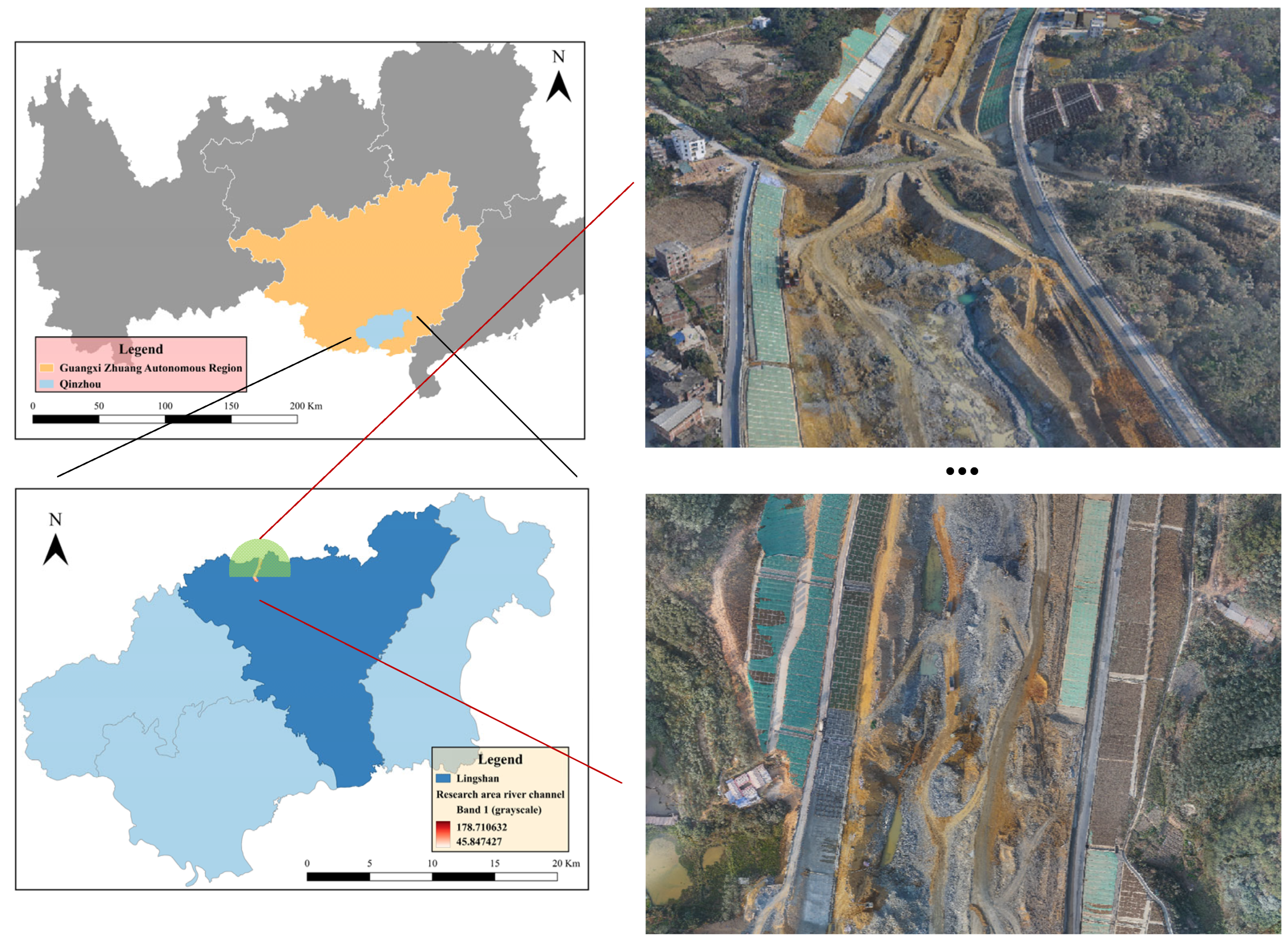
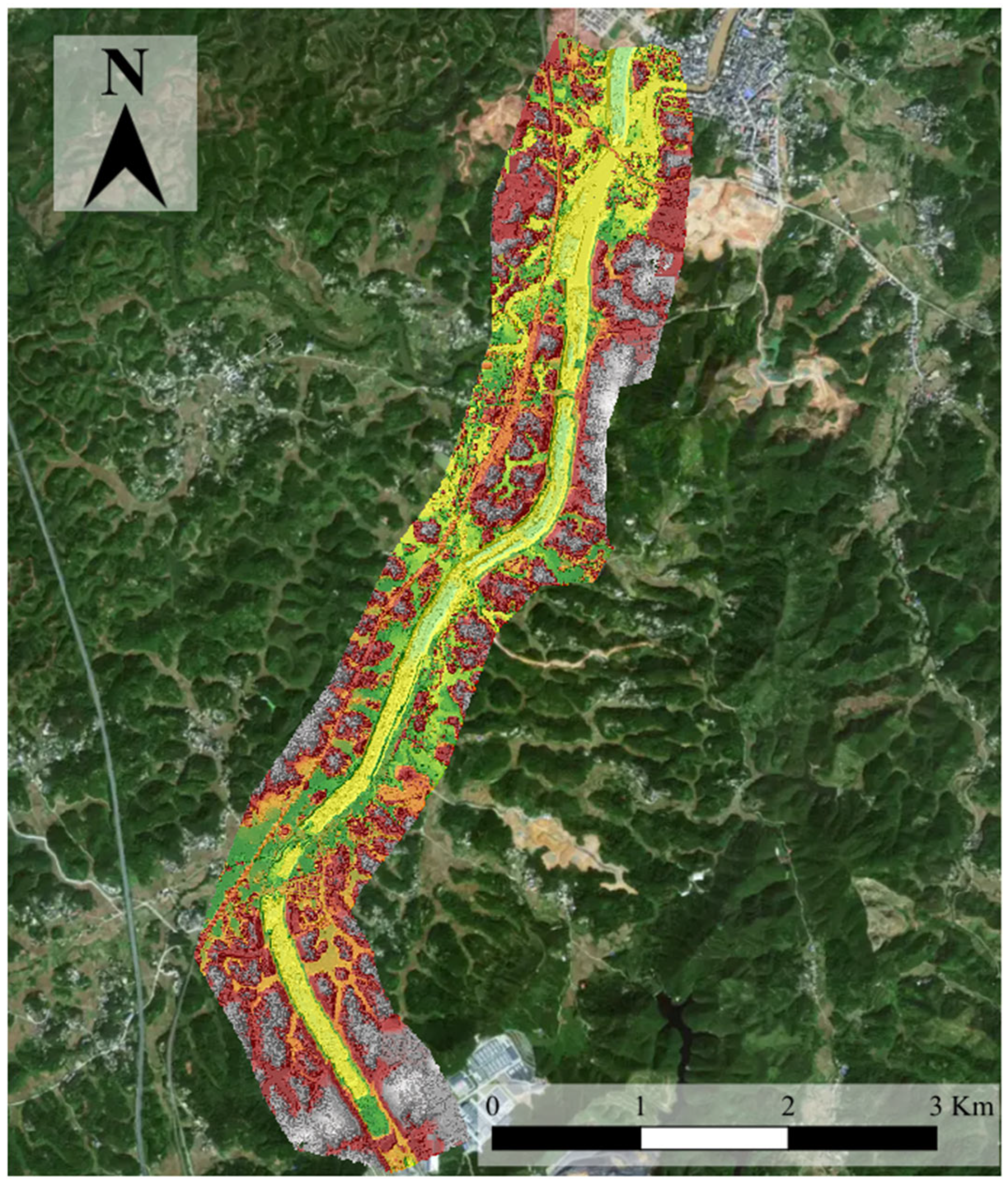
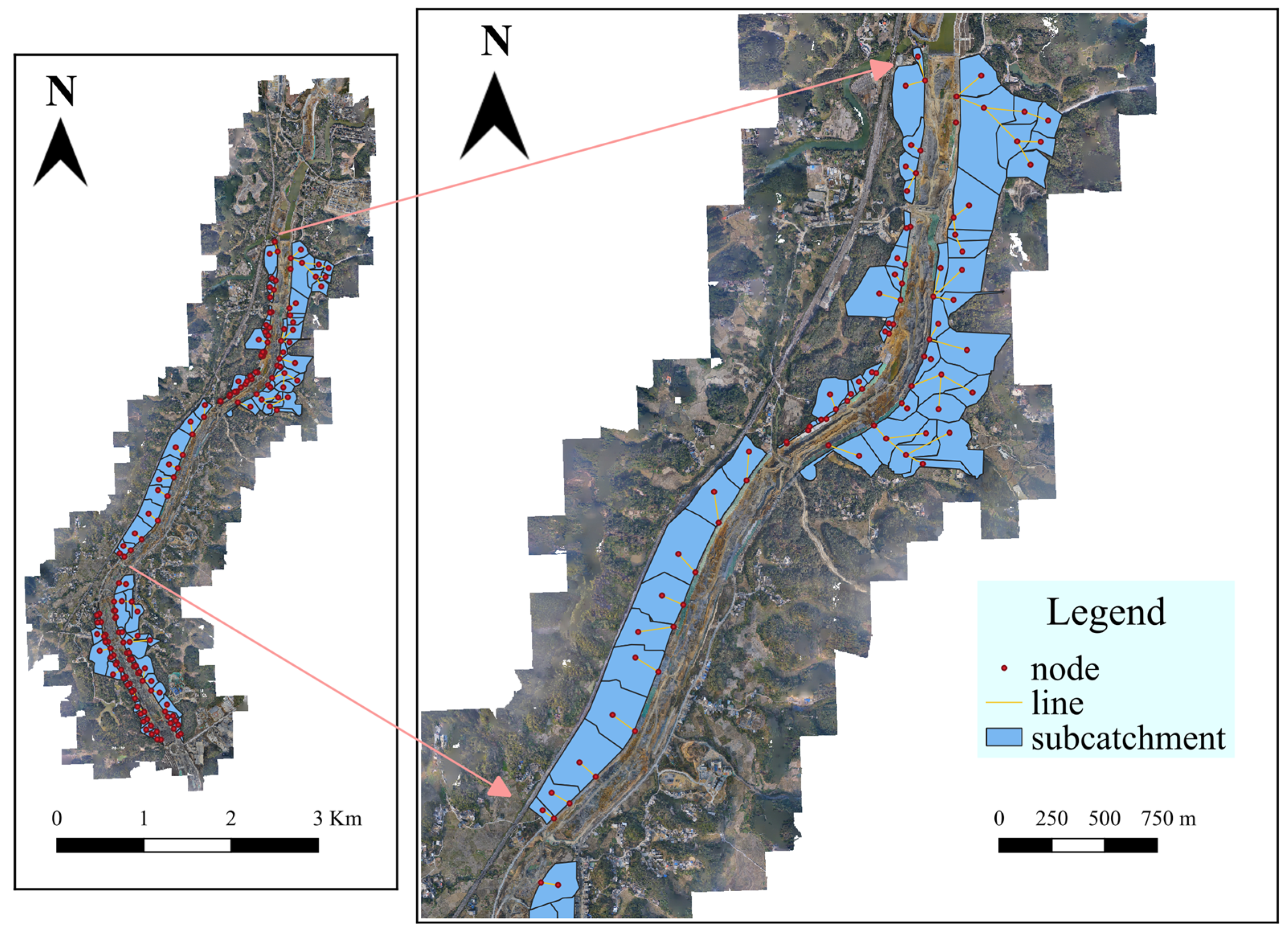
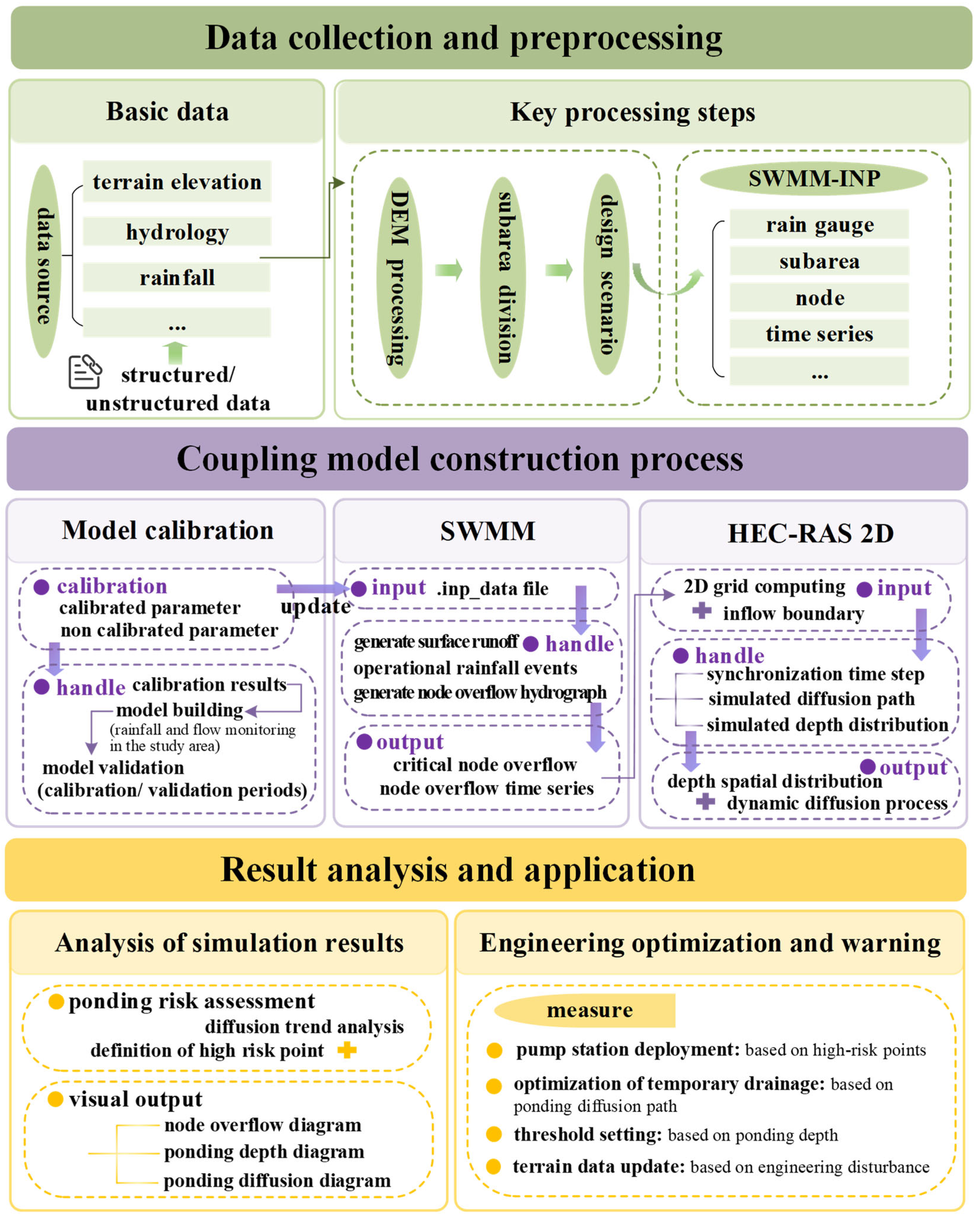

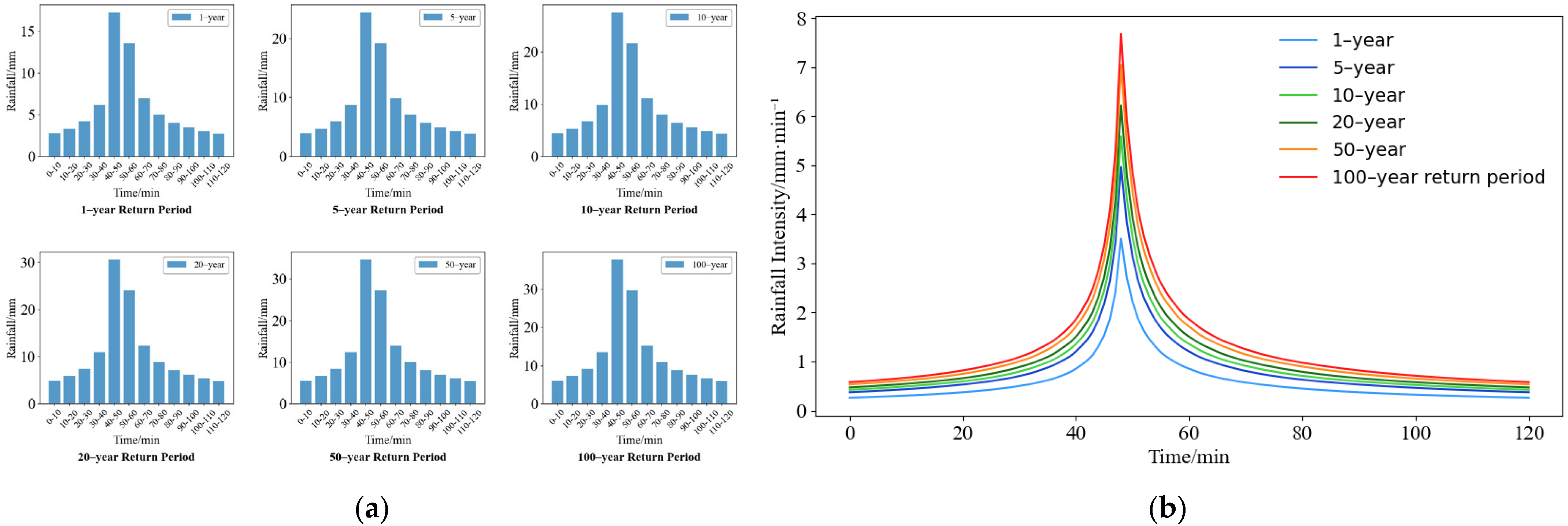
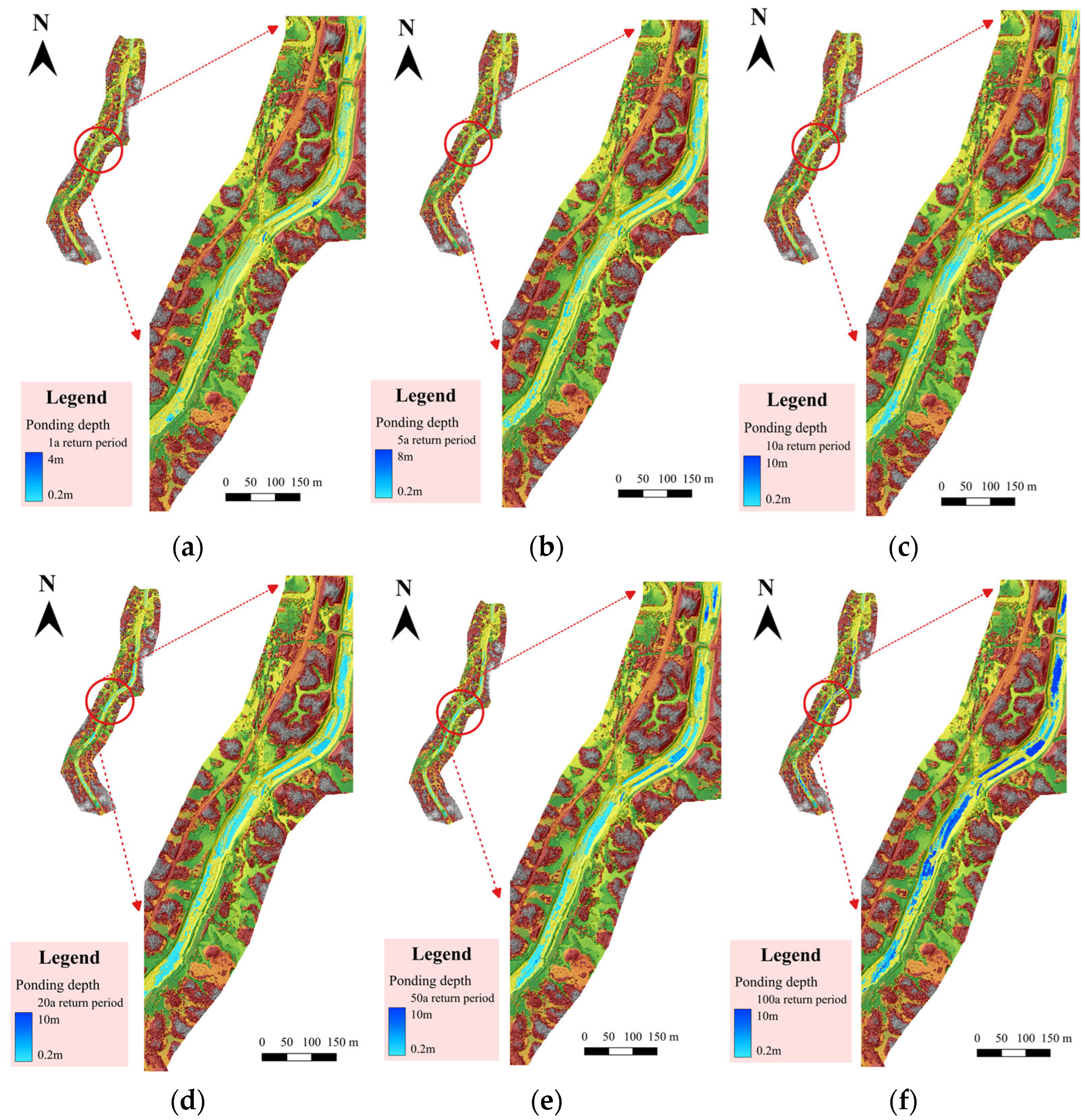

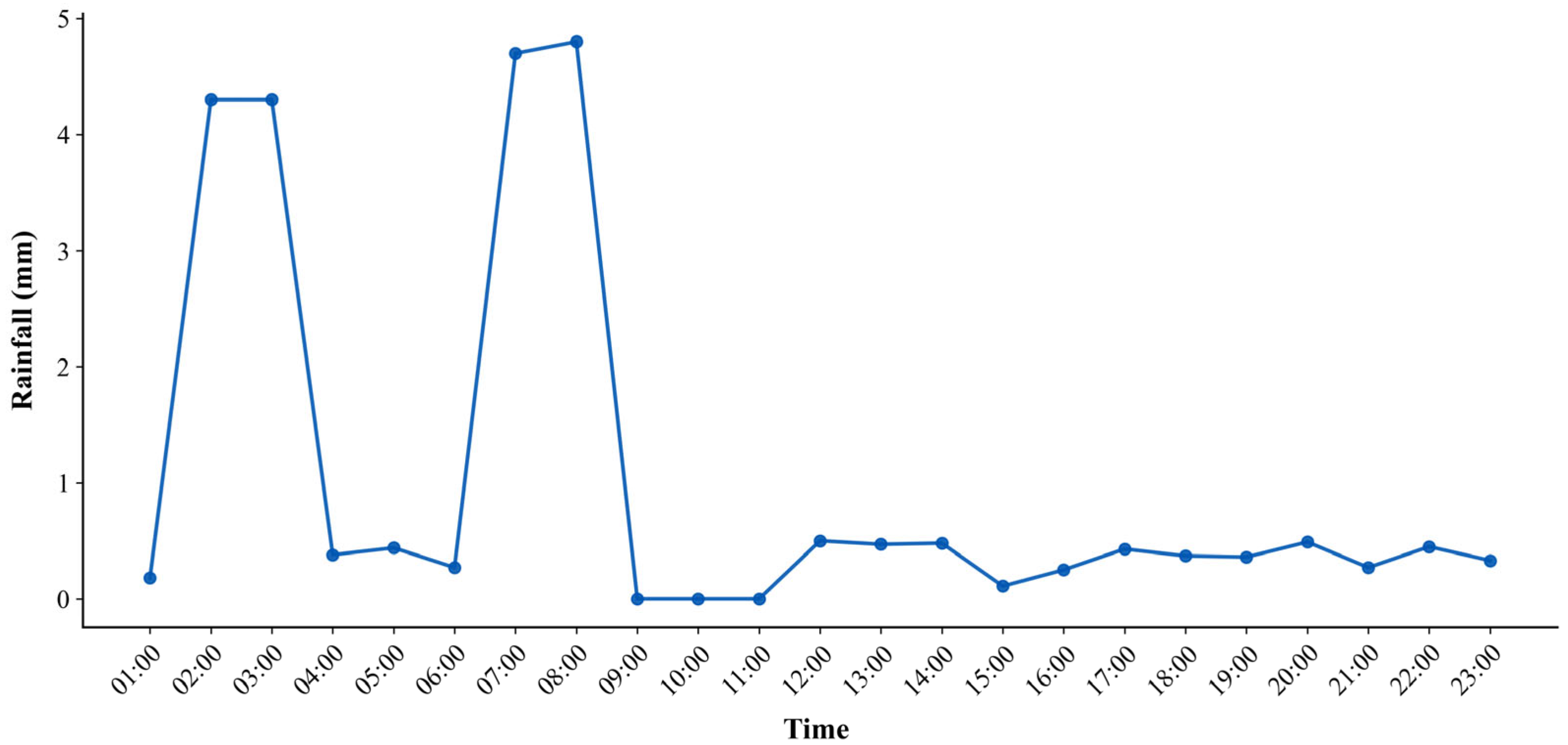
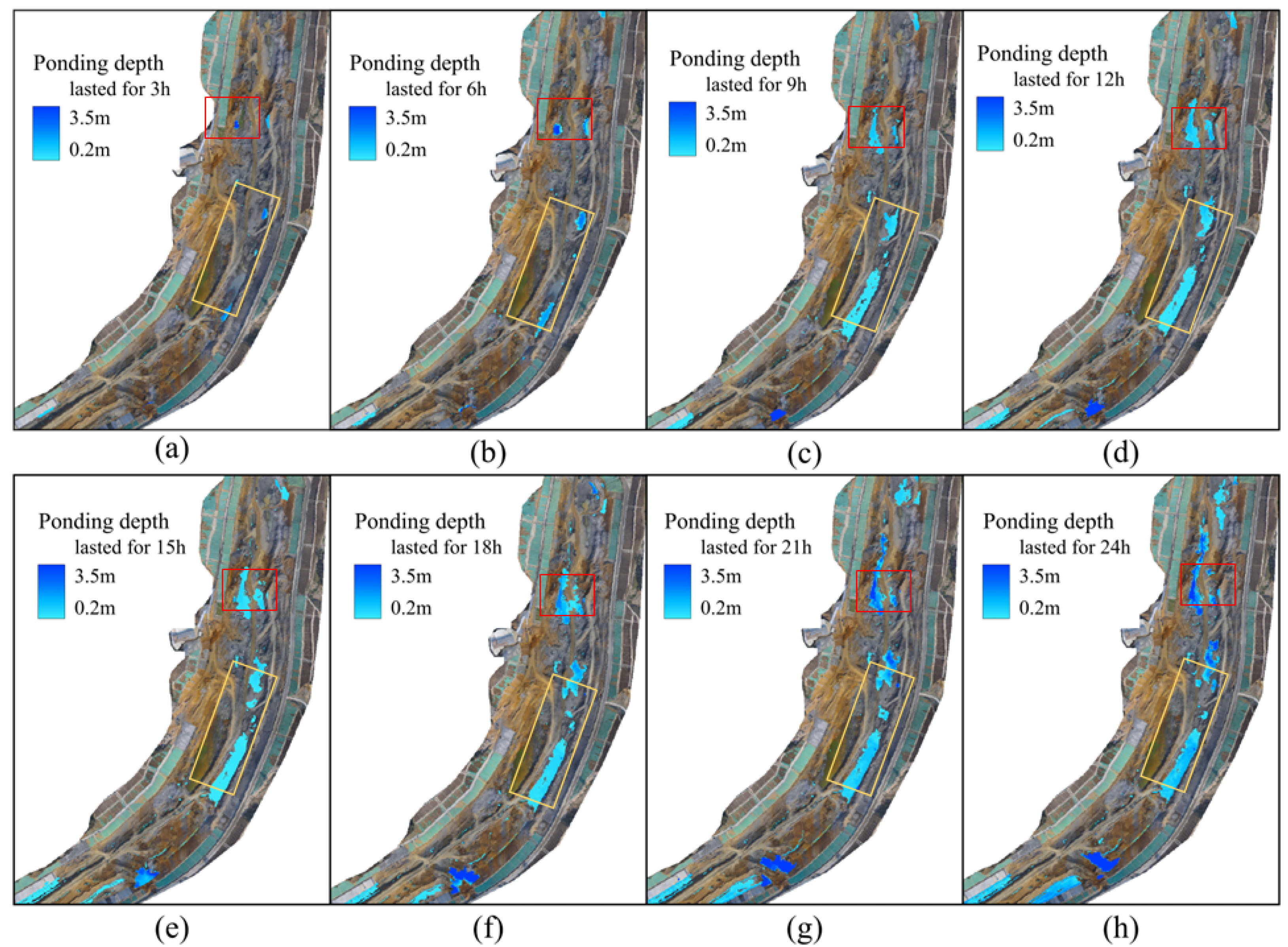
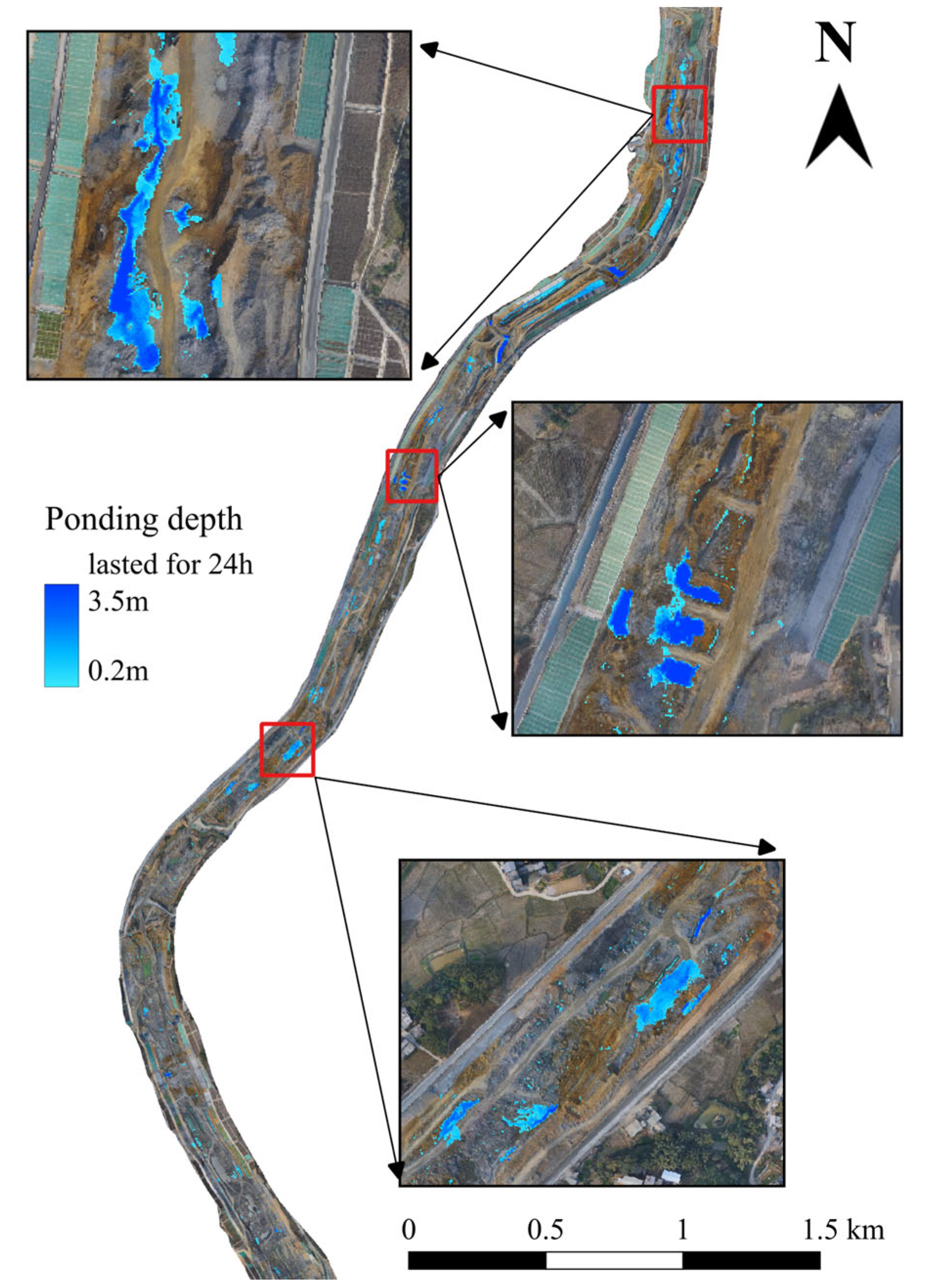
| Model | Advantages | Disadvantages | Explanation |
|---|---|---|---|
| SWAT | Suitable for long-term hydrological simulation of large watersheds | insufficient accuracy in simulating short-term rainstorm runoff | waterlogging during the construction period is a short-term process, which requires higher temporal resolution |
| TOPMODEL | Based on the terrain index, it is suitable for mountainous watersheds | difficult to handle complex terrains under artificial disturbances | The terrain of the construction area changes dynamically, which is inconsistent with the model assumptions |
| MIKE 11/21 | High accuracy in hydrodynamic simulation | High computational cost and weak adaptability to temporary construction boundaries | Coupling efficiency lower than that of the SWMM-HEC-RAS combination |
| SWMM-HEC-RAS | 1D hydrology + 2D hydrodynamics coupling, balancing efficiency and accuracy | Requires support from fine topographic data | This study overcomes this limitation through UAV-LiDAR data |
| Meaning | Parameter Name | Calibration Results | Calibration Range Basis (Source) |
|---|---|---|---|
| manning coefficient of impervious area | N-Imperv | 0.035 | Determined by SWMM User Manual’s recommended range (0.02–0.04) for hardened ground and this study’s 30 on-site measured averages (0.030–0.038). |
| manning coefficient of pervious area | N-perv | 0.08 | Referring to the study on hydrological scenario disturbed areas (0.07–0.09),this study’s area vegetation coverage (<10%) measured data was matched. |
| storage capacity in impervious area/mm | S-Imperv | 2 | Determined based on on-site measured depression storage (1.8–2.5 mm) of construction area hardened pavement. |
| depression storage in permeable area/mm | S-perv | 4 | Referring to disturbed soil porosity test results (4–6 mm) and Green-Ampt model’s default depression storage range for permeable surfaces. |
| maximum infiltration rate/mm·h−1 | Max. Infil. Rate | 82 | Based on double-ring infiltrometer measured disturbed soil maximum infiltration rate (75–90 mm·h−1) |
| minimum infiltration rate/mm·h−1 | Min. Infil. Rate | 10 | For stable infiltration rate of saturated soil, referring to measured disturbed soil infiltration data in saturation (8–12 mm·h−1) |
| Infiltration attenuation coefficient | Decay | 4.2 | Based on fitting of infiltration rate decay curve for rainfall duration, referring to parameter range of similar hydrological infiltration models (3.7–4.5) |
| Rainfall Event | 24 h Cumulative Rainfall (mm) | Peak Intensity (mm/h) | NSE | R2 | RMSE (m) |
|---|---|---|---|---|---|
| 15 April 2025 | 92.6 | 6.2 | 0.78 | 0.82 | 0.13 |
| 28 April 2025 | 45.3 | 3.8 | 0.81 | 0.85 | 0.11 |
| 8 May 2025 | 168.9 | 9.5 | 0.83 | 0.87 | 0.09 |
| Measure Type | Core Equipment/Materials | Unit Price (CNY) | Typical Usage (For 50-Year Return Period) | Single-Item Cost (10,000 CNY) | Proportion of Monthly Section Budget |
|---|---|---|---|---|---|
| Small Submersible Pumps | 50 m3/h portable pumps | 800/day (rental) | 5 units × 3 days | 1.2 | 0.25% |
| Mobile Pumping Stations | 200 m3/h diesel pump trucks | 1200/day (rental) | 2 units × 5 days | 1.2 | 0.25% |
| Temporary Steel Pipelines | Φ300 mm spiral steel pipes | 80/m (incl. installation) | 1.5 km | 12.0 | 2.5% |
| Emergency Open Ditches | 0.5 m × 0.3 m trapezoidal ditches | 50/m (incl. shoring) | 2 km | 10.0 | 2.1% |
Disclaimer/Publisher’s Note: The statements, opinions and data contained in all publications are solely those of the individual author(s) and contributor(s) and not of MDPI and/or the editor(s). MDPI and/or the editor(s) disclaim responsibility for any injury to people or property resulting from any ideas, methods, instructions or products referred to in the content. |
© 2025 by the authors. Licensee MDPI, Basel, Switzerland. This article is an open access article distributed under the terms and conditions of the Creative Commons Attribution (CC BY) license (https://creativecommons.org/licenses/by/4.0/).
Share and Cite
Li, J.; Feng, J.; Wang, Q.; Zhang, Y. Construction-Induced Waterlogging Simulation in Pinglu Canal Using a Coupled SWMM-HEC-RAS Model: Implications for Inland Waterway Engineering. Water 2025, 17, 2415. https://doi.org/10.3390/w17162415
Li J, Feng J, Wang Q, Zhang Y. Construction-Induced Waterlogging Simulation in Pinglu Canal Using a Coupled SWMM-HEC-RAS Model: Implications for Inland Waterway Engineering. Water. 2025; 17(16):2415. https://doi.org/10.3390/w17162415
Chicago/Turabian StyleLi, Jingwen, Jiangdong Feng, Qingyang Wang, and Yongtao Zhang. 2025. "Construction-Induced Waterlogging Simulation in Pinglu Canal Using a Coupled SWMM-HEC-RAS Model: Implications for Inland Waterway Engineering" Water 17, no. 16: 2415. https://doi.org/10.3390/w17162415
APA StyleLi, J., Feng, J., Wang, Q., & Zhang, Y. (2025). Construction-Induced Waterlogging Simulation in Pinglu Canal Using a Coupled SWMM-HEC-RAS Model: Implications for Inland Waterway Engineering. Water, 17(16), 2415. https://doi.org/10.3390/w17162415





